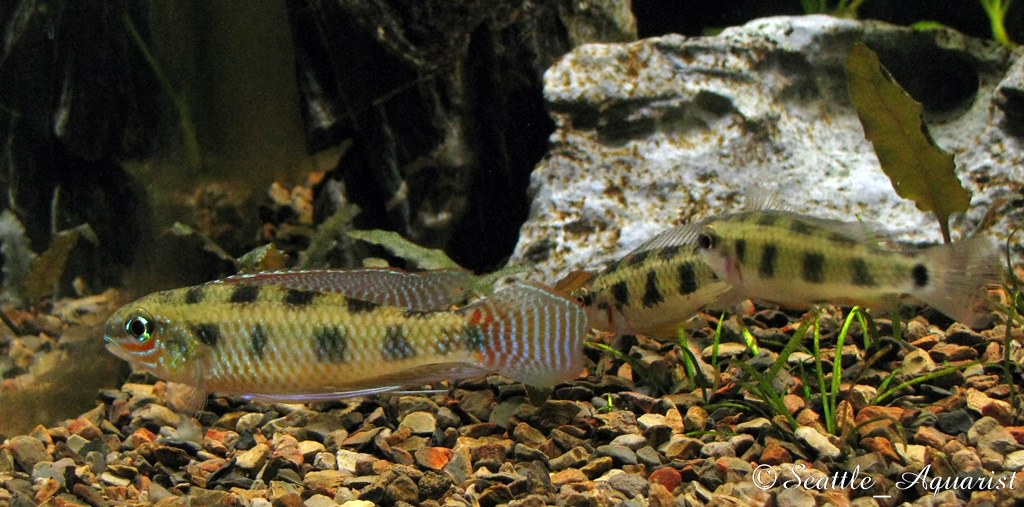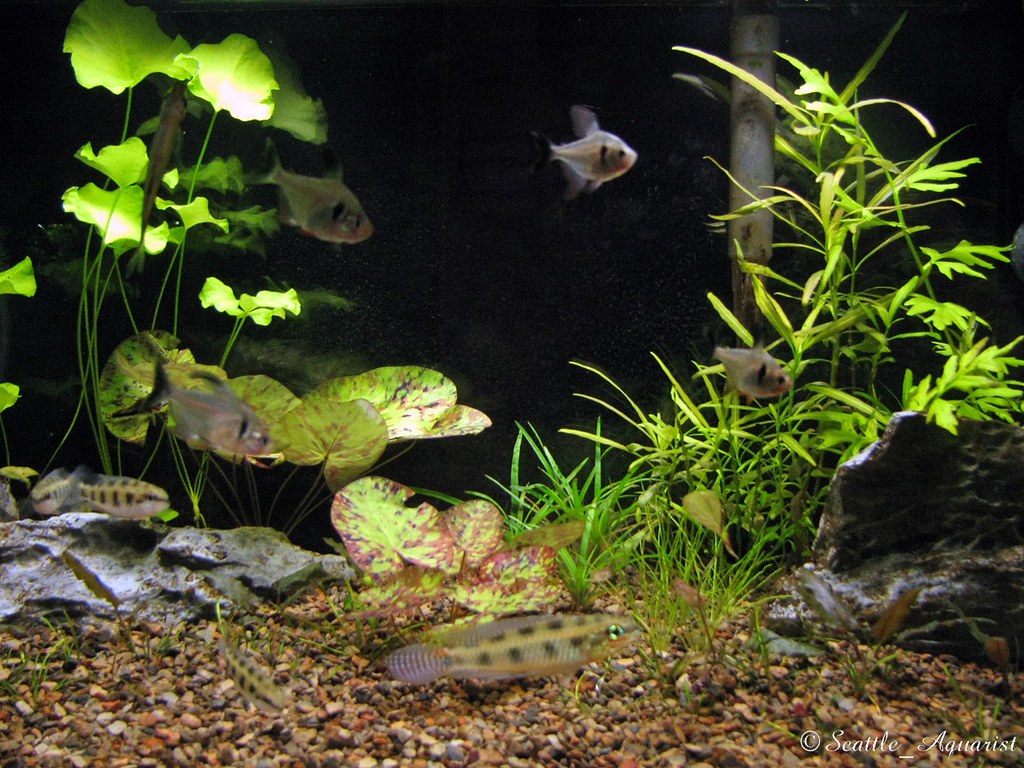You are using an out of date browser. It may not display this or other websites correctly.
You should upgrade or use an alternative browser.
You should upgrade or use an alternative browser.
Roy's 10 gallon - Dicrossus maculatus species tank
- Thread starter Seattle_Aquarist
- Start date
Seattle_Aquarist
Well-Known Member
Thanks clownie! Wild caught fish (or F1 or F2) always seem to show more color intensity than fish from the Asian fish farms. My hope is to spawn these guys in six months or so, I don't believe I have seen tank raised fish or this species offered in the past.
Seattle_Aquarist
Well-Known Member
Stunning fishes! Will your plants tolerate the really low pH (3-4) that you would need in order to get them to spawn?
Hi sir_keith,
I will be moving these guys in the next month to a 20 gallon so they can continue to grow well; likely with changes to the hardscape and water parameters. You are correct, this species hales from blackwater, tannin rich waters that are low in light and are basically devoid of plant life - just branches and leaf litter from the canopy jungle. From what I have read successful spawning will require very, very low pH so it is unlikely that plants will survive. However, if they do show signs of spawning behavior as they mature I may try to spawn them in 6.0 -6.4 pH and see what happens.
Hi sir_keith,
I will be moving these guys in the next month to a 20 gallon so they can continue to grow well; likely with changes to the hardscape and water parameters. You are correct, this species hales from blackwater, tannin rich waters that are low in light and are basically devoid of plant life - just branches and leaf litter from the canopy jungle. From what I have read successful spawning will require very, very low pH so it is unlikely that plants will survive. However, if they do show signs of spawning behavior as they mature I may try to spawn them in 6.0 -6.4 pH and see what happens.
Super cool; keep us posted. I've seen some of these black water Amazon tributaries, and they are the color of tea! And they smell- well- ripe! But best be careful of the snakes!
Actually, this species comes from the Tapajos and other clearwater areas vs. it's more common blackwater cousin, D. filamentosus.
I didn't know that. And these clearwater areas have this crazy low pH? How does that work? Or is it only seasonal?
Seattle_Aquarist
Well-Known Member
Hi All,
It's been a month since my last update. The Dicrossus maculatus are continuing to grow and thrive. They get fed twice a day; usually I give them live blackworms in the mornings and either frozen bloodworms or Ken's Flake Food in the evenings.
The male is probably 4X the size and females 2X the size that they were when purchased. The male has been 'displaying' but the females don't have the full bodies or reddish pelvic areas indicating they are ready to mate but I have only had them for 3 months and they were wild juvies when I received them.
The Black Phantom Tetras have worked out fairly well as dither fish, the Dicrossus are 'out and about' most of the time however the tetras are more aggressive feeders so I have to watch and make sure that the Dicrossus are getting sufficient food.
Dicrossus maculatus (wild; immature)

It's been a month since my last update. The Dicrossus maculatus are continuing to grow and thrive. They get fed twice a day; usually I give them live blackworms in the mornings and either frozen bloodworms or Ken's Flake Food in the evenings.
The male is probably 4X the size and females 2X the size that they were when purchased. The male has been 'displaying' but the females don't have the full bodies or reddish pelvic areas indicating they are ready to mate but I have only had them for 3 months and they were wild juvies when I received them.
The Black Phantom Tetras have worked out fairly well as dither fish, the Dicrossus are 'out and about' most of the time however the tetras are more aggressive feeders so I have to watch and make sure that the Dicrossus are getting sufficient food.
Dicrossus maculatus (wild; immature)

Seattle_Aquarist
Well-Known Member
Hi @sir_keith
The females are 1" and the male is 1.75" not counting the tails. I like the Black Phantom Tetras as well, basic black and silver with a white streak on either side of the black stripe up by the gill plates. Not at all aggressive toward the Dicrossus which is most important. I picked up six, four females and a male from Aquarium Co-op and a male from The Fish Store.

The females are 1" and the male is 1.75" not counting the tails. I like the Black Phantom Tetras as well, basic black and silver with a white streak on either side of the black stripe up by the gill plates. Not at all aggressive toward the Dicrossus which is most important. I picked up six, four females and a male from Aquarium Co-op and a male from The Fish Store.
